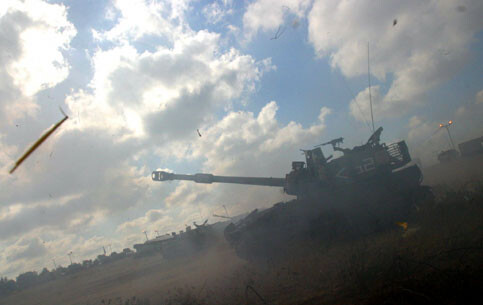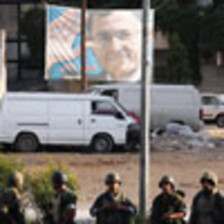The Electronic Intifada 14 July 2006

An Israeli army tank fires towards Gaza Strip at a position near Kibbutz Nahal Oz, northern Gaza Strip, 9 July 2006. (MaanImages/Inbal Rose)
Imagine a group of high ranking generals who simulated for years Third World War scenarios in which they can move huge armies around, employ the most sophisticated weapons in their disposal and enjoy the immunity of a computerized headquarters from which they can direct their war games. Now imagine that they are informed that in fact there is no Third World War and their expertise is needed to calm down some of the nearby slums or deal with soaring crime in deprived townships and impoverished neighborhoods. And then imagine - in the final episode in my chimerical crisis - what happens when they find out how irrelevant have their plans been and how useless are their weapons in the struggle against the street violence produced by social inequality, poverty and years of discrimination in their society. They can either admit failure or decide none the less to use the massive and destructive arsenal at their disposal. We are witnessing today the havoc wreaked by Israeli generals who opted for latter course of action.
I have been teaching in the Israeli universities for 25 years. Several of my students were high ranking officers in the army. I could see their growing frustration since the outbreak of the first Intifada in 1987. They detested this kind of confrontation, called euphemistically by the gurus of the American discipline of International Relations: ‘low intensity conflict’. It was too low to their taste. They were faced with stones, molotov bottles and primitive arms which required a very limited use of the huge arsenal the army has amassed throughout the years and did not test at all their ability to perform in a battlefield or a war zone. Even when the army used tanks and F-16s, it was a far cry from the war games the officers played in the Israeli Matkal – headquarters – and for which they bought, with American tax payer money – the most sophisticated and updated weaponry existing in the market.
The first Intifada was crushed, but the Palestinians continued to seek ways of ending the occupation. They rose again in 2000, inspired this time by a more religious group of national leaders and activists. But it was still a ‘low intensity conflict’; no more than that. But this is not what the army expected, it was yearning for a ‘real’ war. As Raviv Druker and Offer Shelah, two Israeli journalists with close ties to the IDF, show in a recent book, Boomerang (p. 50), major military exercises before the second Intifada were based on a scenario that envisaged a full-scale war. It was predicted that in the case of another Palestinian uprising, there would be three days of ‘riots’ in the occupied territories that would turn into a head-on confrontation with neighboring Arab states, especially Syria. Such a confrontation, it was argued, was needed to maintain Israel’s power of deterrence and reinforce the generals confidence in their army’s ability to conduct a conventional war.
The frustration was unbearable as the three days in the exercise turned into six years. And yet, the Israeli army’s main vision for the battlefield is today still that of ‘shock and awe’ rather than chasing snipers, suicide bombers and political activists. The ‘low intensity’ war questions the invincibility of the army and erodes its capability to engage in a ‘real’ war. More important than anything else, it does not allow Israel to impose unilaterally its vision over the land of Palestine – a de-Arabized land mostly in Jewish hands. Most of the Arab regimes have been complacent and weak enough to allow the Israelis to pursue their policies, apart from Syria and Hizballah in Lebanon. They have to be neutralized if Israeli unileteralism is to succeed.
After the outbreak of the second Intifada in October 2000, some of the frustration was allowed to evaporate with the use of 1,000 kilo bombs on a Gaza house or during operation Defense Shield in 2002 when the army bulldozered the refugee camp in Jenin. But this too was a far cry from what the strongest army in the Middle East could do. And despite the demonization of the mode of resistance chosen by the Palestinians in the second Intifada – the suicide bomb – you needed only two or three F-16 and a small number of tanks to punish collectively the Palestinians by totally destroying their human, economic and social infrastructure.
I know these generals as well as one could know them. In the last week, they have had a field day. No more random use of one-kilo bombs, battleships, choppers and heavy artillery. The weak and insignificant new minister of defense, Amir Perez, accepted without hesitation the army demand for crushing the Gaza strip and grinding Lebanon to dust. But it may not be enough. It can still deteriorate into a full scale war with the hapless army of Syria and my ex-students may even push by provocative actions towards such an eventuality. And, if you believe what you read in the local press here, it may even escalate into a long distance war with Iran, backed by a supreme American umbrella.
Even the most partial reports in the Israeli press of what was proposed by the army to Ehud Olmert’s government as possible operations in the coming days, indicate clearly what enthuses the Israeli generals these days. Nothing less that a total destruction of Lebanon, Syria and Tehran.
The politicians at the top are more tamed, to a point. They have only partially satisfied the army’s hunger for a ‘high intensity conflict’. But their politics of the day are already donned by military propaganda and rational. This why Zipi Livni, Israeli foreign minister, an otherwise intelligent person, could say genuinely on Israeli TV tonight (13 July 2006) that the best way to retrieve the two captured soldiers ‘is to destroy totally the international airport of Beirut’. Abductors or armies that have two POWs of course immediately go and buy commercial tickets on the next flight from an international airport for the captors and the two soldiers. ‘But they can sneak them with a car’, insisted the interviewers. ‘Oh indeed’ said the Israeli Foreign Minister, ‘This is why we will also destroy all the roads in Lebanon leading outside the country’. This is good news for the army, to destroy airports, set fire to petrol tanks, blow up bridges, damage roads and inflict collateral damage on a civilian population. At least the airforce can show its ‘real’ might and compensate for the frustrating years of the ‘low intensity conflict’ that had sent Israel’s best and fiercest to run after boys and girls in the alleys of Nablus or Hebron. In Gaza the airforce has already dropped five such bombs, where in the last six years it dropped only one.
This may be not enough, though, for the army generals. They already say clearly on TV that ‘we here in Israel should not forget Damascus and Teheran’. Past experiences tell us what they mean by this appeal against our collective amnesia.
The captive soldiers in Gaza and Lebanon have already been deleted from the public agenda here. This is about destroying the Hizballah and Hamas once and for all, not about bringing home the soldiers. In a similar way in the summer of 1982, the Israeli public have totally forgotten the victim that provided the government of Menachem Begin with the excuse of invading Lebanon. He was Shlomo Aragov, Israel’s ambassador to London on whose life an attempt was made by a splinter Palestinian group. The attack on him served Ariel Sharon with the pretext of invading Lebanon and staying there for 18 years.
Alternative routes for the conflict are not even raised in Israel, not even by the Zionist left. No one mentions commonsensical ideas such as an exchange of prisoners or a commencement of a dialogue with the Hamas and other Palestinian groups at least over a long ceasefire to prepare the ground for more meaningful political negotiations in the future. This alternative way forward is already backed by all the Arab countries, but alas only by them. In Washington, Donald Ramsfeld may have lost some of his deputies in the Defense Department, but he is still the Secretary. For him, the total destruction of the Hamas and Hizballah – whatever the price and if it is without loss of American life – will ‘vindicate’ the raison d’être for the Third World Theory he propagated early on in 2001. The current crisis for him is a righteous battle against a small axis of evil – away from the quagmire of Iraq and a precursor for the so far unattained goals in the ‘war against terror’ – Syria and Iran. If indeed to a certain extent the Empire was serving the proxy in Iraq, the full fledged support President Bush gave to the recent Israeli aggression in Gaza and Lebanon, shows that may be pay off time has come: now the proxy should salvage the entangled Empire.
Hizballah wants back the piece of southern Lebanon Israel still retains. It also wishes to play a major role in Lebanese politics and shows ideological solidarity with both Iran and the Palestinian struggle in general, and the Islamist one, in particular. The three goals do not always complement each other and resulted in a very limited war effort against Israel in the last six years. The total resurrection of tourism on the Israeli side of the border with Lebanon testifies that, unlike the Israeli generals, for its own reasons the Hizballah is very happy with a very low intensity conflict. If and when a comprehensive solution for the Palestine question will be achieved even that impulse would die out. Crossing 100 yards into Israel proper is such an action. Retaliating to such a low key operation with a total war and destruction indicates clearly that what matters is the grand design not the pretext.
There is nothing new in this. In 1948, the Palestinians opted for a very low intensity conflict when the UN imposed on them a deal which wrested from their hand half of their homeland and gave it to a community of newcomers and settlers, most of whom arrived after 1945. The Zionist leaders waited for long time for that opportunity and launched an ethnic cleansing operation that expelled half of the land’s native population, destroyed half of its villages and dragged the Arab world into unnecessary conflict with the West, whose powers were already on the way out with the demise of colonialism. The two designs are interconnected: the wider Israel’s military might expands, the easier it is to complete the unfinished business of the 1948: the total de-Arabization of Palestine.
It is not too late to stop the Israeli designs from creating a new and terrible reality on the ground. But the window of opportunity is very narrow and the world needs to take action before it is too late.
Related Links
Ilan Pappe is senior lecturer in the University of Haifa Department of political Science and Chair of the Emil Touma Institute for Palestinian Studies in Haifa. His books include among others The Making of the Arab-Israeli Conflict (London and New York 1992), The Israel/Palestine Question (London and New York 1999), A History of Modern Palestine (Cambridge 2003), The Modern Middle East (London and New York 2005) and forthcoming, Ethnic Cleansing of Palestine (2006)





